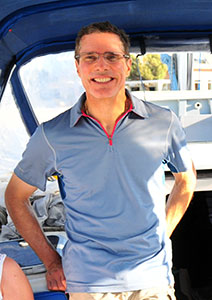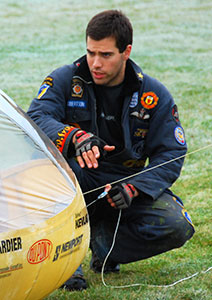
There really are no limits to the opportunities available as an engineering science (EngSci) graduate. It takes just one look at the Robertsons—three success stories of University of Toronto engineering science alumni over two generations—to demonstrate the driving force of EngSci to establish lasting careers and push the boundaries of the impossible.
 The father: Clive Robertson
The father: Clive Robertson
Clive Robertson (EngSci 8T0) was the EngSci vanguard of the Robertson family, selecting the chemical option, which was available at the time during his degree. His foray into chemical engineering resulted in his thesis in polymer chemistry entitled “Coupling Agents in Mica-Reinforced Polypropylene.”
His foundational studies and specific experience with polymers led him directly to a position at DuPont Canada, where he established a long-lasting career in the performance polymers division. In addition to his engineering contributions, he has also spent the past 20 years doing business and market development as the global marketing manager for energy and advanced development.
During his time at U of T, Clive shared classes with students such as Jun Nogami (MSE), the current chair of the Department of Materials Science & Engineering, and even met his prospective wife, Elaine Campbell (ChemE 8T0), who sits on the Department of Chemical Engineering & Applied Chemistry’s Board of Advisors.
He was also very active, playing squash and nurturing an interest in sailing and the outdoors. Clive personally vouches for the broad knowledge that the first two foundational years gave him, allowing him the span of many possible pursuits. The opportunities available to him during his undergraduate EngSci studies have really given him the means to a successful and fulfilling career in the engineering industry.
 The brother: Bruce Robertson
The brother: Bruce Robertson
Bruce Robertson (EngSci 8T3) entered engineering science within a few short years of his brother, Clive. Bruce shared an interest in materials and composite structures with Clive, driving him to choose the materials science option in his third year. For his thesis, Bruce delved into the structural testing of concrete components, experimenting with the curing process and mix variation in order to produce maximal structural parameters.
His aptitude for structural composition and materials science led to his role as one of the three founding employees of Aercoustics, an engineering company with a focus on the acoustics, noise and vibrational aspects of structural design and innovation. Bruce is currently involved in a small derivative company but has expanded his pursuits well beyond engineering.
He always demonstrated a passion for sailing, rock climbing and other outdoor adventures, proving himself to be quite the world traveller. He is known to especially love South America, and recently returned from a solo trans-Atlantic sailing expedition. He has even obtained a certificate in holistic and naturopathic medicine and is currently writing an illustrated book on medicinal plants that have been identified by North American Aboriginal Peoples. With the combination of his wide span of interests, engineering education and adventurous attitude, it seems Bruce will never run out of fascinating pursuits.
 The son: Cameron Robertson
The son: Cameron Robertson
Following closely in his father Clive’s footsteps, Cameron Robertson (EngSci 0T8, UTIAS MASc 0T9) enrolled in engineering science. However, after the two foundational years, Cameron truly took flight and specialized in the aerospace option, showing a marked interest in human-powered feats of engineering.
This interest developed into his undergraduate thesis “Structural Optimization of a Human-Powered Ornithopter Wing,” which explored the topic of human-powered flight. Cameron began to work in tandem with fellow EngSci aerospace graduate Todd Reichert (EngSci 0T5, UTIAS PhD 1T1) on the design and construction of Snowbird, a human-powered ornithopter, the flight of which had been deemed impossible.
Following his graduation in 2008, Cameron began a master’s degree at the University of Toronto Institute of Aerospace Studies (UTIAS) with the continuation of his quest for the impossible. His master’s thesis, entitled “Structural Characterization, Optimization, and Failure Analysis of a Human-Powered Ornithopter,” outlined his extensive research into the formula for successful human-powered flight.
The Snowbird proved successful in 2010 and the project was awarded the CASI Trans-Canada McKee Trophy. With the inception of AeroVelo, Cameron and Todd were determined to continue their endeavours to achieve the impossible. Their next project, the Atlas Human-Powered Helicopter, won them the AHS Igor I. Sikorsky Human-Powered Helicopter Prize, which had remained unclaimed for more than three decades.
Their current focus at AeroVelo includes pushing the limits of human speed through the development of the world’s fastest human-powered vehicle, a speed bike called Eta for its efficiency. It is evident in his work with AeroVelo that the culmination of his engineering science education, continuing studies at UTIAS, and his passion for design has truly driven Cameron to achieve feats previously deemed impossible.
He remains very involved at the Division of Engineering Science, recently presenting a lecture during the 2014 Engineering Science Education Conference (ESEC) on AeroVelo’s successes and aspirations.
In addition to his work with AeroVelo, Cameron is also one of three instructors for the infamous AER201 Engineering Design course in which second-year EngSci students design and construct a fully autonomous robot to perform a specific set of tasks. Cameron himself was in charge of the electro-mechanical subsystem during his own AER201 course, claiming it to be a time-consuming but overall very rewarding role.
Cameron attributes much of his successful to the general foundation in EngSci as well as his involvement in many of the U of T design teams. Interestingly enough, Cameron also met his prospective wife, Nicole Chatterton (CivE 0T9), during his time at U of T Engineering.
Generations of ingenuity
While their career paths may have diverged, their shared interest in structures, materials science and composites is evident in their respective accomplishments. Among their engineering achievements, the Robertsons have also maintained many of the same hobbies and interests from their university days, including sailing, outdoor activities and various sports, including squash.
But it is their passion, drive and adventurousness, along with a shared foundation in EngSci, which has really defined them in their endeavours. EngSci or not, it can be said with certainty that the Robertson family will continue to make a positive impact on the engineering society, as well as the world at large.
— Alexandra Davidson (EngSci 1T7)
This is article was first published on the Division of Engineering Science’s website.
